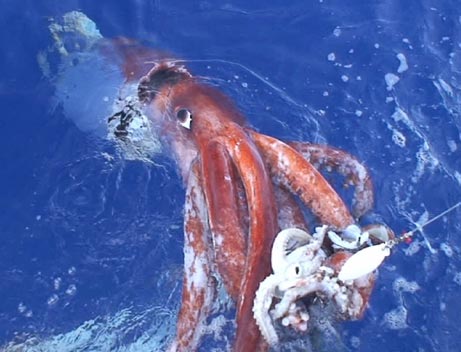Battle of Epic Proportions

What sorts of crazy thoughts would be going through your head if you had the unique opportunity to witness something as large as a school bus (37 ft) fighting with something as large as an 18-wheeler semi truck (60-70 ft)? Think about it next time you are out on the road… Because, believe it or not, beneath the surface of the ocean battles of such epic proportions are common occurrences.

Introducing the Giant and Colossal Squids (school bus) versus the Sperm Whale (18-wheel truck)!
These animals are enormous: Giant Squid reach estimated maximum lengths of 33 feet for males and 43 feet for females; Colossal Squid are estimated to reach maximum lengths of 39-46 feet and weigh more that the Giant Squid; and an adult Sperm Whale which is the largest toothed animal is over 60 feet (claims of up to 67 feet). It may seem strange that there are not exact numbers for the lengths of these animals… take into account, though, that these creatures spend the majority of their time at or below depths of at least 3,000 feet. Sperm whales are the deepest diving mammals and have been recorded swimming down to 9,200 feet (that’s 1.8 miles straight down!).

Since all mammals breathe air, you are more likely to see a sperm whale near the surface.. and very unlikely to ever come across a squid on the surface. It is not uncommon for dead giant squid to be found floating or on beaches, but very few people have ever seen the animals alive. In fact almost all of our knowledge of squid come from dead or dying specimens.
In 2004, Japanese scientists captured the first ever photos of a live giant squid in the wild. 500 images were taken near Japan’s Ogasawara Islands. Just 2 years later (2006), led by the same scientist – Tsunemi Kubodera – a team successfully filmed a live giant squid at the surface!!! No one has done that before or since.
Check out the video footage here!
Back to the battle part! So, why do these guys fight each other anyway? Well, to put

it simply… sperm whales like calamari too! And if you are 60 feet long and weigh 56 tons, a few common market squid probably will not quite fill you up. No one has ever actually witnessed these animals duke it out, but we know it happens because when examining the stomach contents of deceased sperm whales the large beaks of both colossal and giant squids have been recovered. In fact, beaks found in stomachs are one of the most critical clues scientists have for comparing and estimating maximum sizes of the squid. Perhaps the giant molluscs actually get much larger, but because of their larger size they are less likely to be eaten by a whale, and therefore less likely to be discovered by humans.


Though many beaks have been found in whale stomachs, giant squid do not make for an easy meal – they are fast, strong, and armed (literally! Get it?). Each of the 8 arms and the pads of the 2 tentacles are covered with suction cups which can be up to 2 inches in diameter. Each suction cup is surrounded by a serrated ring of chitin, which basically means they wield the weapon of lots of tiny circular vacuum powered steak knives – watch out whales! Many sperm whales are seen with circular scars all over their head from previous battles. The whales have a cool trick, though – they are able to create a sonic blast which they can “shoot” at their prey. The sound they produce is so loud (in fact it is the 2nd loudest animal sound, second only to the tiger pistol shrimp) that some scientists believe it may be capable of actually stunning the squid long enough for the whale to grasp its prey with the large conical teeth lining the whale’s narrow lower jaw.

So now, every time you find yourself in traffic near a school bus and an 18-wheel truck/trailer… think about the epic battles that could be going on in the deep waters of oceans all around the world. And though it unlikely that you will see any of these beasts when you join Sail Caribbean for one of our Marine Biology Summer Camps, you will almost certainly meet the small reef squid common to the area. Sperm whales, however, do reside in the Caribbean Sea and are occasionally seen in the waters around the British Virgin Islands (usually in the winter months). Typically most of the sightings are in nearby Dominica – the only country known where sperm whales live year round.
What other “monsters” of the sea are you interested in learning about? If you could safely be in the water with any large animal, which one would it be?
